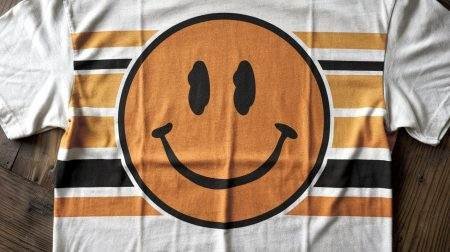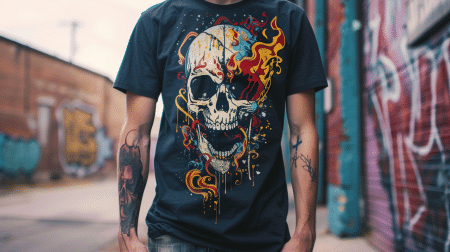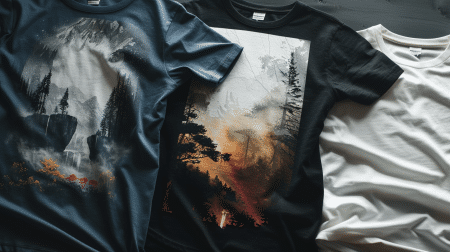
From Vintage to Modern: The Evolution of Graphic Tees in Fashion
Graphic tees have a rich history that dates back to the early 20th century. The concept of putting images and text on t-shirts first gained popularity in the 1950s, when companies started using them as promotional tools. One of the earliest examples of a graphic tee is the iconic “I ♥ NY” shirt, which was created in 1977 to promote tourism in New York City. This simple yet powerful design paved the way for the graphic tee trend to take off.
In the 1980s, graphic tees became a staple in pop culture, with bands and musicians using them as a way to promote their music and connect with fans. The rise of MTV and music videos also played a significant role in popularizing graphic tees, as fans wanted to emulate the style of their favorite artists. Vintage designs from this era often featured bold, colorful graphics and catchy slogans that reflected the vibrant and rebellious spirit of the time.
The Rise of Graphic Tees in Pop Culture and Streetwear
The 1990s saw the rise of streetwear culture, which further propelled the popularity of graphic tees. Brands like Stüssy, Supreme, and A Bathing Ape emerged as pioneers in the streetwear scene, creating graphic tees that resonated with the youth culture. These tees often featured edgy and subversive designs, making them a form of self-expression for those who wore them. The rise of hip-hop and skateboarding also played a significant role in popularizing graphic tees, as they became synonymous with urban culture and street style.
In the early 2000s, graphic tees became a mainstream fashion staple, with celebrities and influencers embracing the trend. The democratization of fashion through social media and online platforms also contributed to the widespread popularity of graphic tees, as they became a way for individuals to showcase their personal style and interests. Today, graphic tees continue to be a dominant force in pop culture and streetwear, with new designs constantly pushing the boundaries of creativity and self-expression.
The Influence of Graphic Tees in High Fashion and Runway Shows
In recent years, graphic tees have made their mark in high fashion and runway shows, blurring the lines between streetwear and luxury fashion. Designers like Virgil Abloh, Demna Gvasalia, and Raf Simons have incorporated graphic tees into their collections, elevating them from casual wear to high-end fashion statements. These designers have reimagined graphic tees with avant-garde designs and unexpected collaborations, making them coveted pieces in the fashion world.
The influence of graphic tees in high fashion has also extended to runway shows, where they are often styled with tailored pieces and couture garments. This juxtaposition of casual and formal elements has redefined the way graphic tees are perceived, proving that they can be just as impactful on the runway as they are on the streets. The fusion of high fashion and streetwear has opened up new possibilities for graphic tee design, allowing for more experimentation and innovation in the industry.
The Evolution of Graphic Tee Design: From Band Tees to Statement Tees
The evolution of graphic tee design has been shaped by various cultural movements and subcultures, resulting in a diverse range of styles and aesthetics. Band tees have been a longstanding staple in graphic tee fashion, with iconic designs from bands like The Rolling Stones, Pink Floyd, and Nirvana becoming timeless classics. These tees often feature album artwork, tour dates, and band logos, serving as a form of merchandise for fans to show their allegiance to their favorite artists.
In recent years, statement tees have become a dominant trend in graphic tee design, featuring bold slogans, political messages, and social commentary. These tees have become a platform for individuals to express their beliefs and values, sparking conversations and raising awareness on important issues. The rise of statement tees has also led to collaborations between fashion brands and non-profit organizations, using graphic tees as a means to support charitable causes and make a positive impact.
The Impact of Technology on Graphic Tee Production and Design
Advancements in technology have revolutionized the production and design process of graphic tees, allowing for more intricate and detailed prints. Digital printing techniques have made it possible to create photorealistic images and complex designs on t-shirts, giving designers more creative freedom to experiment with different visual elements. This has led to a surge in custom and personalized graphic tees, as individuals can now create their own unique designs with ease.
The rise of e-commerce platforms and print-on-demand services has also democratized the graphic tee industry, making it more accessible for independent designers and small businesses to enter the market. This has led to a proliferation of niche and niche-specific graphic tees, catering to specific interests and subcultures that may not have been represented in mainstream fashion. Technology has also played a role in sustainability efforts within the industry, with advancements in eco-friendly printing methods and materials reducing the environmental impact of graphic tee production.
The Sustainability Movement in Graphic Tee Fashion
As consumers become more conscious of their environmental footprint, there has been a growing demand for sustainable and ethical practices within the fashion industry, including graphic tee fashion. Many brands have responded to this call by implementing eco-friendly materials, such as organic cotton and recycled fabrics, into their graphic tee production. This shift towards sustainability has not only reduced the environmental impact of graphic tee production but has also raised awareness about ethical fashion practices among consumers.
In addition to using sustainable materials, some brands have also embraced ethical manufacturing processes, ensuring fair wages and safe working conditions for garment workers. This commitment to ethical production has resonated with consumers who are increasingly seeking out brands that align with their values. The sustainability movement in graphic tee fashion has also sparked innovation in design, with brands experimenting with eco-friendly dyes and printing techniques that minimize water usage and chemical waste.
The Future of Graphic Tees: Trends and Innovations in the Industry
Looking ahead, the future of graphic tees is poised for continued innovation and evolution. As technology continues to advance, we can expect to see more interactive and immersive designs on graphic tees, incorporating augmented reality and digital elements that blur the line between fashion and technology. Customization will also play a significant role in the future of graphic tees, with advancements in 3D printing and on-demand manufacturing allowing for personalized designs tailored to individual preferences.
Sustainability will remain a key focus in the future of graphic tee fashion, with brands continuing to prioritize eco-friendly materials and ethical production practices. This commitment to sustainability will not only benefit the environment but will also resonate with consumers who are increasingly seeking out conscious fashion choices. As the industry continues to evolve, we can expect to see more collaborations between fashion brands and artists, musicians, and non-profit organizations, using graphic tees as a platform for creative expression and social impact.
In conclusion, graphic tees have come a long way since their humble beginnings as promotional tools in the 1950s. From their roots in pop culture and streetwear to their influence in high fashion and runway shows, graphic tees have become a powerful form of self-expression and cultural commentary. As technology continues to shape the industry and sustainability becomes an increasingly important focus, the future of graphic tees is poised for continued innovation and creativity. Whether it’s through bold slogans or intricate designs, graphic tees will continue to be a canvas for individuals to showcase their personal style and make a statement about the world around them.








Add comment